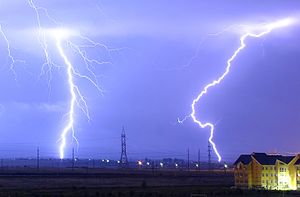 Image by Getty Images via @daylife
Image by Getty Images via @daylifeThe carbon tax that ate Australia Anthony Cox
http://www.abc.net.au/unleashed/113676.html
The carbon tax has inflamed the old conflicts between progressives and conservatives – between those who favour government-imposed solutions, and the free-market capitalists or those who simply mistrust big government.
“Every dollar raised by the carbon price will be dedicated to supporting households with any price impacts, and supporting businesses through the transition to a clean energy economy.”
This is impossible. Under the “Fast Start Finance” commitment from Cancun, which Combet announced, $599 million will be given to the IPCC under Australia’s combating AGW obligations. This $599 million is on top of the commitment made by Australia at Cancun to give 10% of revenue raised from a carbon tax to the IPCC. Then there will be the bureaucratic expansion to run the tax, checking compliance and eligibility criteria; these administration costs apparently run at 50% for the Australian government. All this probably explains why Combet’s boss, PM Gillard, is saying “more than 50 per cent of money raised [from the carbon pricing scheme] will go to assisting households.”
Spain’s experiment with a carbon tax and subsidisation of wind and solar resulted in 2.2 jobs lost for every green job bought by subsidies. Italy fared even worse with 4.8 jobs lost for every green job bought by subsidy. Similar results occurred in Germany and Denmark.
In 2009 the then NSW Labour government commissioned Frontier Modelling to analyse the effect the 5% ETS proposed by the then Rudd government would have on the Australian GDP. The modelling showed a $2 trillion reduction in the Australian economy directly linked to the effect of the ETS by 2050; that’s $50 billion per annum; enough to pay for the NBN.
The shrinkage occurs because green energy is both far more expensive than conventional energy and does not meet the society’s needs. California is the classic example of this. California’s sweet ride with green energy began in 1973-4 with the first oil shock; this experiment gained momentum in the 1980s when the US government offered big tax breaks for wind power. After 40 years of massive investment and cutting edge technology in wind and solar California today obtains only 2.4% and 0.4% from those 2 sources. As for moral leadership, despite banning coal mining California still receives nearly 10% of its power from coal, all imported. California’s dominant energy source is gas.( Obtaining a poisonous non-renewable fuel and destroying the aquifer simultaneously...in a desert. )
That proof that a carbon tax represents a massive shift towards big government lies in the already available details in the government’s National Greenhouse Emissions Reporting website [NGER].
NGER lists all the corporations currently obligated to report their emissions of CO2; this obligation is based on a threshold which only catches the largest of businesses; this threshold will be lowered or non-existent with the advent of a carbon tax after the Greens gain power on the 1st July 2011, so the total revenue collectable from a carbon tax will be much larger the NGER indicates at present.
But that's not all. The NGER structures the carbon tax as a DOUBLE tax applying both to the production of energy [Scope 1] and the use of that energy [Scope 2].
The figures are staggering. Scope 1 emissions are just under 341 million tonnes. Because the use in Scope 2 will approximate the emissions from Scope 1 another 341 million tonnes can be added for a total of 682 million tonnes of emissions. The Greens preferred CO2 tax rate is $45 per tonne; at that rate the carbon tax will extract $15 billion from the Australian economy per year. And that’s before agriculture and petrol are slugged.
Australian Unemployment Sept 2008 - Sept 2009
Beyond Zero Emissions
 Image via Wikipedia
Image via WikipediaPower Plant: One Small Leaf Could Electrify an Entire Home
http://www.technewsworld.com/story/Power-Plant-One-Small-Leaf-Could-Electrify%20an-Entire-Home-72156.html?wlc=1308496391
Scientists at MIT have created what may be the first practical artificial leaf -- a device about the size of a playing card capable of splitting water into hydrogen and oxygen and storing the energy in a fuel cell. Placing the leaf it in a single gallon of water in sunlight could produce enough electricity to supply a house in developing countries with its daily electricity requirement, according to researchers.
 Image via Wikipedia
Image via Wikipedia Image via Wikipedia
Image via Wikipedia- Sustainability, energy independence and agricultural policy
http://ergosphere.blogspot.com/2006_11_01_archive.html
Renewable Energy Facts
Another Zero Carbon Australia 2020 Critique
Zero Carbon Australia, M. Wright and Hearps, Univ. of Melbourne, Energy Institute, August 2010.
by Ted (F.E.) Trainer, Social Work, University of NSW, Kensington.
The ZCA report argues that Australia could run entirely on renewable energy by 2020.
I think this lengthy and detailed report is a valuable contribution to the energy discussion, containing much up to date information and many ideas and proposals that are promising. I believe it heads in the general direction Australia should take. However I think the report is quite mistaken in its optimism, that is in its conclusion that Australia can convert to renewables. This conclusion is based on a number of assumptions, some of which seem to me to be highly challengeable.
My current understanding of the global (not Australian) situation is summarised in “Can renewables etc solve the greenhouse problem — The negative case.” Energy Policy, Aug. 2010, (which I will refer to below as CAN). ZCA has helped me to see some mistakes in my analysis, which will enable improvement of my current attempt to apply the general approach to the Australian situation.
The issue is of course absolutely crucial and ZCA has made a significant contribution to the process whereby we try to sort out the situation. ZCA concludes that there is a neat and simple way growth and affluence society can be made sustainable, quickly and affordably. My view is that global problems cannot be solved within or by a society committed to affluence and growth. The potential of renewables is a central issue in this gigantic debate, (although it is not crucial, that is, even if renewable energy turns out to be sufficient there are many other reasons for scrapping the core systems in this society, especially to do with global economic injustice.
In China, the true cost of Britain's clean, green wind power experiment: Pollution on a disastrous scale
This toxic lake poisons Chinese farmers, their children and their land. It is what's left behind after making the magnets for Britain's latest wind turbines... and, as a special Live investigation reveals, is merely one of a multitude of environmental sins committed in the name of our new green Jerusalem
The Energy Report - A fully sustainable and renewable global energy system is possible by 2050 - Go to the official WWF page for more on this report.Download part 1 of the report, The Energy Report (PDF, 6.6 MB)Download part 2 of the report, The Ecofys Energy Scenario (PDF, 4.8 MB).
Fracking Fluids "Glow" With Radiation
( Much more on fracking in Water - Wealth & Power )
Natural Gas: Avoidable Health Hazard
David Wimberly ( email )
Natural Gas Health Information Coalition N.S.
October 2000If you value your health, don't burn gas indoors. Natural gas has caused more cases of environmental illness than any other substance, even than pesticides.
Recent scientific studies strongly link indoor natural gas use to increased asthma and respiratory illness. If you already have environmental illness or asthma, avoiding natural gas use is crucial. But it is equally important to realize that everyone can lessen the risk of developing illness by avoiding natural gas use. Cook stoves are commonly the worst application, but space heaters, fireplaces, dryers, hot water heaters and furnaces all adversely contribute. The Maritimes have the worst rates of asthma and environmental illness in Canada, so why expose those you love to needless risk?
The introduction of natural gas to the Maritimes is a juggernaut that is difficult to resist as government and business are falling over themselves to promote it. However all the hype just covers up the surprising, awful truth. Government contrived deviously to avoid any evaluation during the rigged environmental assessment of the environmental, social and health effects of the actual USE of natural gas. Why? Because the truth is - it isn't good for the environment to use gas, gas use suppresses, not promotes, truly sustainable energy alternatives and gas is bad for the public's health in indoor uses.
The immediate question facing Maritimers is, "Should I connect my home or business to use natural gas?" We say that it is a risk better avoided.Energy Surprise 'shale gas' intro
Some 200,000 in Germany protest nuclear power- The NPT and the nuclear power TRAP
- ( also at Politics of Perception | Foreign Policy )
The NPT is tightly organized around nuclear power, which is a TRAP –a Toxic RadioActive Proliferator. NPT Groupthink is still driven by archaic ideas, beliefs, interests, language, symbols and images that are frozen in consciousness and eclipse deeper understanding and constrain wiser actions. As the third pillar of nuclear energy keeps knocking down the other two pillars – non-proliferation and disarmament - might the system designed to prevent proliferation paradoxically provoke proliferation?
Whether we can collectively break out of these traps is a matter of consciousness and demystifying ourselves from nuclear myths and illusions. To free ourselves, we must recognize the ways in which we are trapped.
The Nuclear Power TRAP
Framing nuclear energy as a right creates an artificial value and right to demand. It manipulates desire and seduces many leaders and citizens into a dangerous lifestyle, devoting precious resources to creating an infrastructure harmful to their financial, health, political and environmental interests.
- Closing old atom plants poses safety challenge: IAEA
 Image via Wikipedia
Image via Wikipedia
- Energy from Thorium
The Energy Blog
Energy Bulletin - Energy News
- Energy resources and our futureAdmiral Rickover - 1957
The Ergosphere
Gas Resources Corporation
Nuclear Issues
Faith in fission
-
OilPrice
SourceWatch Portal - coal issues
The Oil Drum
The Oil DrumDiscussions about energy and our future Image by Getty Images via Daylife
Image by Getty Images via Daylife
Mendo Coast Current
Nuclear Information and Resource Service
NukeFree.org
Renewable Energy Syndicator
Repower America
 Image via Wikipedia
Image via WikipediaReegle : Search Engine for Renewable Energy and Energy Efficiency
Renewable Energy & Non Renewable Energy - Eco 20/20
- Solar Alliance Growth of the Tarpits SolveClimate Developing nations reject 'nuclear fuel bank' pretext This Week in Petroleum Tribal Energy and Environmental Clearinghouse What Really Happened at Three Mile Island and Chernobyl On the Philippine Bataan Nuclear Power Plant Revival: Lessons from the French Experience Understanding the terms behind Peak oil WTRG Economics The Watt-Energy Discussion Webring The Energy Collective
 Image via Wikipedia
Image via WikipediaOut of options
A surprising culprit in the nuclear crisis
Japan’s reactors are “light water” reactors, whose safety depends on an uninterrupted power supply to circulate water quickly around the hot core. A light water system is not the only way to design a nuclear reactor. But because of the way the commercial nuclear power industry developed in its early years, it’s virtually the only type of reactor used in nuclear power plants today. Even though there might be better technologies out there, light water is the one that utility companies know how to build, and that governments have historically been willing to fund.
Economists call this problem “technological lock-in”: The term refers to the process by which one new technology can prevail over another for no good reason other than circumstance and inertia.US Spent Nuclear Fuel Largest Concentration Of Radioactivity On Planet
US has 71,000 metric tons of spent nuclear fuel that is not properly protected
 Image via Wikipedia
Image via Wikipedia
 Image via Wikipedia
Image via Wikipedia









No comments:
Post a Comment